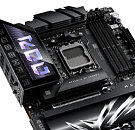
Owners of GIGABYTE X870E AORUS XTREME AI TOP Boards Report 100 °C+ Chipset Temps
A member of GIGABYTE's gaming subreddit has shared a worrying HWiNFO diagnostics readout accompanied by a simple title: "X870E AORUS XTREME AI TOP Chipset with AMD Ryzen 9 9950X3D—Chipset 2 (xHCI) 109.9 °C." Xabiro's initial post attracted replies that disclosed additional feedback regarding higher than expected temperature measurements. Another member—RyanOCallaghan01—exclaimed in the comments section: "damn. I am having the same problem, Chipset 2 is almost reaching 100 degrees Celcius, and I have not even got a high-powered GPU installed. I have seen your image and starting to suspect mine may be the same." The original poster proceeded to disassemble their thermally-challenged X870E AORUS XTREME AI TOP specimen, and quickly identified the root cause—affecting one of the board design's two daisy-chained Promontory 21 chipsets.
Xabiro described this problem-solving process: "I removed the heat sink and actually the top AMD chipset is not touching the heat sink no matter what I do...I didn't have any GPU installed yet, but I just solved (the temperature problem) yesterday, with thermal paste combined with Thermal Grizzly (TG) KryoSheet, just because I didn't have TG Putty Pro. Now the maximum temperature is 65 °C—also on the bottom one was just changed to TG Kryonaut, and it is under 50 °C. Quite ironically, GIGABYTE recently engaged in some public mocking of a troubled ASUS motherboard feature. Xabiro suspected that the X870E AORUS XTREME AI TOP mainboard's EZ Latch Plus GPU quick release system is preventing good contact between surfaces. They observed that: "the plastic ornament which goes from the PCIe to the release button is too high and the top part of the heat sink stays on it, and just simply cannot touch the chipset die."
Xabiro described this problem-solving process: "I removed the heat sink and actually the top AMD chipset is not touching the heat sink no matter what I do...I didn't have any GPU installed yet, but I just solved (the temperature problem) yesterday, with thermal paste combined with Thermal Grizzly (TG) KryoSheet, just because I didn't have TG Putty Pro. Now the maximum temperature is 65 °C—also on the bottom one was just changed to TG Kryonaut, and it is under 50 °C. Quite ironically, GIGABYTE recently engaged in some public mocking of a troubled ASUS motherboard feature. Xabiro suspected that the X870E AORUS XTREME AI TOP mainboard's EZ Latch Plus GPU quick release system is preventing good contact between surfaces. They observed that: "the plastic ornament which goes from the PCIe to the release button is too high and the top part of the heat sink stays on it, and just simply cannot touch the chipset die."











































